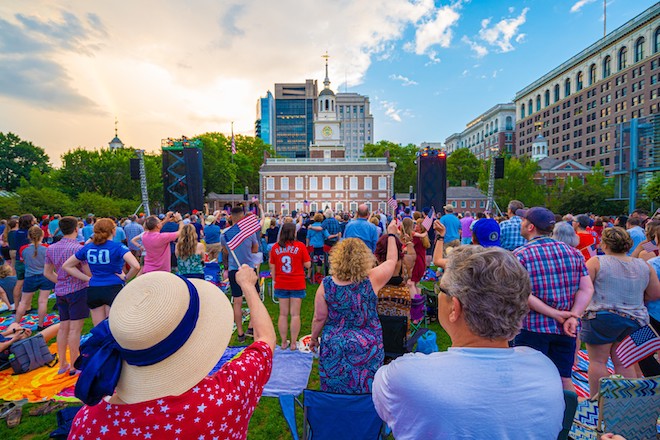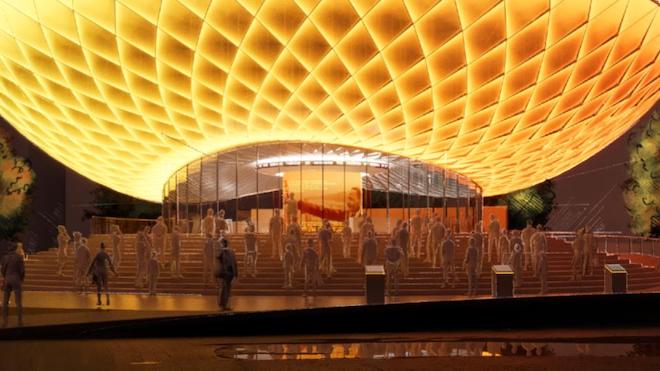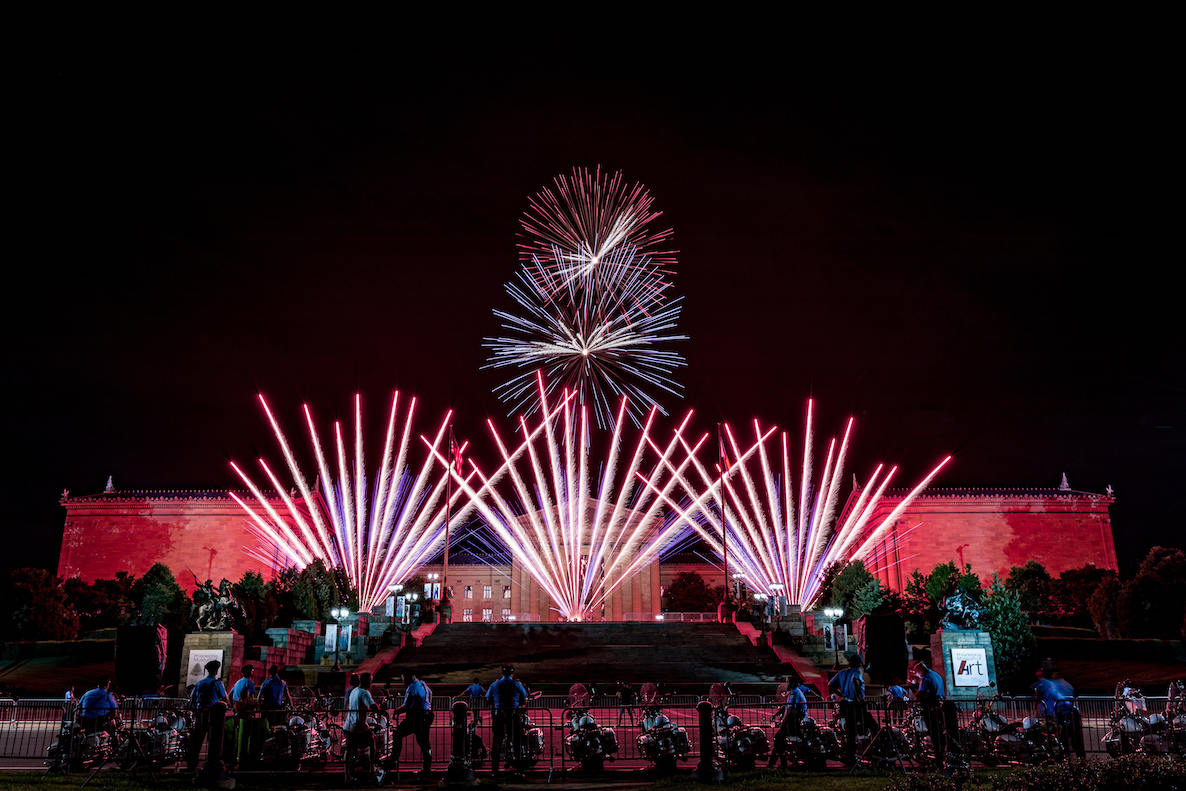“Everyone, no matter who you are — whether you were born here, whether you came here from another country because you were being persecuted, or came here of your own free will for a better life, or if you came here against your will — every single person has contributed to the growth of the United States of America,” says Angela Val, president and CEO of Visit Philadelphia.
Our democracy’s beginnings have been on Val’s mind a lot. She’s a key player in the local planning process for next year’s Semiquincentennial, aka the 250th anniversary of the signing of the Declaration of Independence. [Editor’s note: Val is a Philadelphia Citizen board member.]
Next year should be spectacular. This is Philly, after all, where the thing happened, the birthplace of the nation. Early advocates had big ideas — Host the MLB All-Stars! And the Oscars! Eradicate a disease! Build a new subway! — and dreams of a $2.5 billion budget.

Originally, that vision came from investment firm CEO Andrew Hohns, who in 2016 created USA250, a nonprofit that sought to use 2026 as a catalyst to tackle the sort of infrastructure projects that could make Philadelphia globally competitive. But then … plans for an epic 250th stalled. There came the pandemic, and a checked-out lame duck mayor. But there was also trouble nationally.
A federally created, government-funded America250 subsumed USA250’s role and soon became mired in scandal: patronage, sexism and one CEO’s Trumpian business methods. Hohns, who had been largely cut out of the project by the new entity, soon resigned.
So, Philly went off on our own. USA250 became Philadelphia250, and re-focused on local planning, with mixed results.
Now, with just 15 months left until July 4, 2026, we have to wonder: Are we too late? Can we still throw a good party and leverage this opportunity to make real, lasting change in Philly?
Those questions are weighing heavily on some city leaders, including Val.
“We’re the birthplace of the country,” says Val. “We have an opportunity here to do 2026 right, and it is ours to lose. This will be no one else’s fault but our own.”
Our checkered history of centennial celebrations
For most of the last five-and-a-half years, Philadelphia250 has been run by architect and urban planner Danielle DiLeo Kim, who had ideas about activating neighborhoods, but largely lacked the oomph to get real excitement, funding or development going. Mayor Kenney put it on the back burner in his second term, and Mayor Cherelle Parker had other priorities in her first year, too — Kensington, gun violence, the Sixers arena.
“There were so many things that [Mayor Parker] had to attack immediately. She didn’t have the time to spend leading 2026,” says former Mayor and PA Governor Ed Rendell, who now chairs Philadelphia250.
On the other hand, Parker’s initial budget slated $60 million to make the 250th happen. And, she appointed former Visit Philly exec Michael Newmuis to keep the City onboard with planning. In addition to Newmuis, the efforts are now being led by Val, Rendell, and Philadelphia City Councilmember Isaiah Thomas. When DiLeo Kim announced she’d be leaving last December, Independence Visitor Center Corp President and CEO Kathryn Ott Lovell stepped up to run Philadelphia250.
“This is going to be a once-in-a-generation opportunity to experience your city.” — Kathryn Ott Lovell, Independence Visitor Center Corp. and Philadelphia250
One obstacle organizers have had to face: The perception that Philadelphia has a lot to live up to based on the successes of our previous centennial celebrations. But that’s just not true.
Yes, 1876, was huge and great. Philadelphia built Memorial Hall (now the Please Touch Museum) and hosted the World’s Fair, debuting the telegraph, the telephone, the typewriter and a bunch of other amazing inventions. Ten million people came, and Philadelphia felt important, like the place for innovation.
But 1926 and 1976? They had some high points, sure, but were disastrous overall. In 1926, the City never managed to finish construction on our second World’s Fair — and much of it was destroyed by rain. We did complete the Ben Franklin Bridge, though.
Our bicentennial was notoriously horrific: Sure, we hosted Queen Elizabeth, built the Mann, the Declaration House, the African American Museum and the Mummers Museum. But Mayor Frank Rizzo actively endeavored to frighten visitors away. And he wasn’t wrong: That summer, the grand Bellevue Hotel hosted the nation’s first outbreak of Legionnaires’ Disease, sickening 221 and killing around 30 guests there.
To sum up: Everyone would like 2026 to be more 1876 than 1976.
What Philly needs to make the 250th great in 2026
First: We need money.
Planners have estimated we need $100 million to make our 250th spectacular. Philanthropists were first in, contributing more than $14 million for various projects before this year. In February, Governor Josh Shapiro earmarked almost $65 million to support 250th celebrations statewide (no word how much Philly’s slice will be). A couple weeks ago, Parker upped the City’s promised contribution to $100 million, pending budget approval.
We will know for sure how much money we have for the Sesqui-shindig on June 30, the deadline to approve both PA and municipal budgets — almost exactly a year before July 4, 2026. The dollars can’t come soon enough. “While we may be behind, it is not too late,” says At-Large Councilmember Isaiah Thomas, a key planner.
Second: We need major events. All kinds. As Val says, “The United States has contributed not only democracy. We’ve also contributed food, fashion, sports, music, and culture. That’s what we’re celebrating, too.”
In all, more than 90 grant-funded projects are in planning stages or in progress. (Visit Philly has published and is updating a calendar of events for next year.) They include:
-
- Six FIFA World Cup matches
- Major League Baseball’s All-Star Weekend
- The 2026 PGA Championship (in Newtown Square)
- ArtPhilly, a public citywide, multidisciplinary festival from May 29 through July 4, organized by curator and arts donor Katherine Sachs and other big names in Philly’s art scene
- An enlarged Flower Show, Wawa Welcome America festival and Philadelphia Area Gaming Expo
- A month of events this fall honoring the 250th anniversary of both the U.S. Navy and the Marine Corps — including a fleet parade on the Delaware and a major military picnic on Independence Mall
- Visit Philly’s free TED Democracy series, already underway
- The second Young People’s Continental Congress, for high schoolers from the 13 original colonies
- Weekly events celebrating inventions from Philadelphia, hosted by Old City, Society Hill and Independence National Historical Park
Not a bad start. But there is still time for more: Last week, Mayor Parker asked Will Smith if he’d swing by and recruit other “hometown heroes” — The Roots, Jill Scott, DJ Jazzy Jeff, Black Thought — back for a Parkway concert.
We could also welcome Hamilton back, since they’ve ditched their plans to return to the Kennedy Center next year. After all, in 2026, Independence Park plans to reopen the founder’s favorite stomping grounds as a museum. “We should have the performance on the outside of the First Bank, even if they do just a couple of scenes,” says Val. Your move, Lin-Manuel.
Then, there’s the issue of the … legacy project.
A lasting legacy from our 250th?
Future generations might hear about millions of Semiquincentennial visitors and be impressed, but decades later we see Memorial Hall and the Ben Franklin Bridge. This is what the earliest planners had hoped for 2026, too. Can we still do something like that next year?
There are a few building projects in the works. Fairmount Park’s Lemon Hill Mansion is getting a refresh before hosting FIFA’s 40-day-long Fan Fest. Mural Arts is constructing a FloatLab atop the Schuylkill River near Bartram’s Garden. Independence National Historical Park is undergoing renovations.
Even so, such projects won’t radically transform Philly. “Every time that we’ve celebrated our nation’s history and progress, we’ve done so with huge infrastructure projects, investments and a lot of vision and creative thinking,” says Max Weisman, Councilmember Thomas’s communications director.

Rendell believes a legacy project is what Philly needs to stick the landing for 2026, since, as far as he knows, we’d be the only city doing it. (Boston has talked a big game, but doesn’t have a fifth of our budget; New York has announced little to nothing for next year, and Washington, D.C., well, that mess is anyone’s guess.)
What Rendell’s proposed — and raised $4 million for — is part museum, part public square. The National Light would be a curated, civic space for the open exchange of true ideas — the upsidedown of X. Plans for a main building feature an illuminated, domed meeting area with interactive displays showcasing historic American speeches — Lincoln’s Gettysburg Address and King’s “I Have a Dream” — plus a theater and a gathering space for discussions and performances.
Something like that, Rendell believes, could take us all the way back to democracy’s roots, when citizens of ancient Athens gathered in outdoor assemblies to debate the issues of the day. It could also ameliorate our current crisis of public conversation. “We’re not going in the right direction right now with our civic discourse,” he says. “I think we can help bring the country together and that may be an idealistic view, but I think it’s worth trying.”
“We’re the birthplace of the country … We have an opportunity here to do 2026 right, and it is ours to lose. This will be no one else’s fault but our own.” — Angela Val, Visit Philadelphia
Rendell estimates he’ll need to raise another $12 to $13 million to bring the National Light here. He’s not asking the City for money, just the land, on a 50-year, $1 lease. Rendell’s belief: If the project gets the go-ahead by May, the National Light could open on July 2, 2026 — 250 years to the day when the Continental Congress took the vote for independence. (The current site under consideration is close to Memorial Hall, after LOVE Park was dismissed because the monument is too heavy for the parking garage beneath.)
Councilmember Thomas and his staff are behind the effort. “Governor Rendell has done so much for the city,” Weisman says.“If we can pull this off for him … it would be a really wonderful testament of what we can do when we all work together.”

There is hope, Weisman says, for other major projects. Although we’re too late to complete much, getting shovels in the ground could establish the legacy part of a legacy project.
Take, for example, the Chinatown Stitch, that, if all goes according to plan, will one day reconnect the neighborhood I-676 tore in two. Final Stitch designs are due in 2026. Maybe get it dedicated next year too?
What’s more, a legacy project doesn’t have to be physical: What about leveraging the Mayor’s business and city wage tax cuts to attract a new, major company here in 2026?
“2026 is not just a year,” says Weisman. “It’s an opportunity to start doing this differently as a city … People can see the momentum and the revenue and use that to bring businesses, build projects or just do things differently for the people of Philadelphia.”
Philly could also take a page out of Paris’s playbook, by doubling down on major cleaning up — as that city did with the Seine — and taking the opportunity to reduce the city’s carbon footprint. Plant more trees to rebuild our canopy — the Daughters of the American Revolution have already donated $365,000 to plant and care for 76 trees in Independence Park. Launch more green updates to municipal buildings to meet our existing climate goals.
Weisman understands that such policy-driven proposals “may not be as exciting of a headline as FIFA, but they’re going to change the way that we work as a city. They’re going to change the face of the business community. … I think we’re actually going to see the boom that people have been hoping for.”
365 days of the Super Bowl feeling
If you think of Philly’s great — often spontaneous — celebrations, one thing they have in common is getting us out into our own streets. We danced outside the Convention Center after the 2020 election. We rush to Broad to celebrate Birds’ and Phils’ wins. When we are feeling proudest of our hometown, we run towards, not away from it.
The 2026 planners are mindful that in summer, many, many Philadelphians head for the Shore and the Poconos. These planners are hoping the city will have enough to offer that residents and suburbanites will stick around — and not just in Old City or the stadium district.
Thomas’s office is working on beyond-Center City neighborhood initiatives. Visit Philly is helping small, out-of-the-way Philly businesses enhance their Google profiles, in the hopes that if a visitor stops by, say, the Wagner Museum or goes to a performance in Pennsport, they’ll stay for a meal, maybe check out an independent shop around the corner, thereby boosting the hyper-local economy, adding vibrancy.
“We want Philadelphians to stay here. I hear from a lot of Philadelphians, Oh, I’m going to go out of town. I’m going to Airbnb my house,” says Ott Lovell. But, she warns, “they don’t want to miss this. This is going to be a once-in-a-generation opportunity to experience your city.”
“When I think about 2026, my dream for it would be for it to look like 365 days of the Super Bowl parade,” she adds, “where we are united — one united community with love and pride and compassion for each other.”
Correction: A previous version of this post neglected to mention that Andrew Hohns resigned of his own accord from the organizations planning the Semiquincentennial. The Citizen regrets this oversight.
![]() OUR COVERAGE OF THE DEVELOPING PLANS FOR AMERICA’S 250TH
OUR COVERAGE OF THE DEVELOPING PLANS FOR AMERICA’S 250TH




